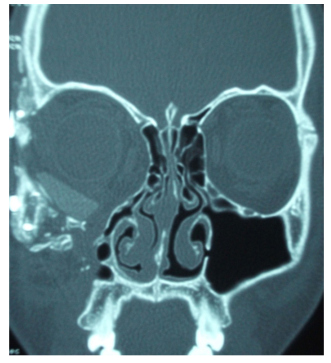OUTCOME FOLLOWING ORBITAL FLOOR FRACTURE RECONSTRUCTION USING SILASTIC IMPLANTS
DOI:
https://doi.org/10.55374/jseamed.v4i2.74Keywords:
Orbital floor fracture, Reconstruction, Silastic sheetsAbstract
Background: Orbital floor fracture is typically present with peri-orbital ecchymosis, subconjunctival hemorrhage, enophthalmos and diplopia. The goals of reconstruction are to restore the volume and shape of the orbital cavity with autogenous or alloplastic materials. However, no gold standard exists for orbital implants to treat orbital floor fractures and remains controversial. Silicone was one of the most common biocompatible materials used for orbital floor reconstruction.
Objective: The study aimed to evaluate the outcomes of patients reconstructed using silastic sheets in the case of orbital wall fractures.
Methods: A multi-center, retrospective study of patients with orbital floor fractures was conducted from January 2010 to December 2019. Inclusion criteria included patients with orbital floor fractures and reconstruction using silastic sheets. Patients with orbital floor fractures and treated with other materials were excluded. The database included age, sex, cause of injury, size of floor defects, associated injury, underlying complication and period of follow-up.
Results: A total of 32 patients with orbital floor fractures divided in 20 patients from Phramongkutklao Hospital and 12 patients from Songkla Hospital were included. Twenty-five patients were male (78.13%). Mean age of patients was 35.62 years (range, 15 to 62 years). Causes of injury included traffic accident (78.13%) and body assault (18.75 %). Pure orbital floor fractures were found at 31.25%. Associated injuries included fractured zygoma 43.75%, nasal bone 21.87% and fractured maxilla 12.50%. Average size of defects was 2.01 cm2. Average time to follow-up was 2.69 years. Complications were found in three cases (extrusion of silicone sheet, loss of sensation and dystopia). Extrusion was found 2 months postoperation and removal of silicone sheet was performed. Complete recovery of sensation of the infra-orbital nerve was shown at 6 months postoperation.
Conclusion: No gold standard exists for implants to treat orbital floor fractures. Orbital floor reconstruction using silastic sheets involves a low complication rate and satisfactory outcome. Herein, silastic sheets can be safely used for orbital wall augmentation and provides good long term outcomes.
Downloads
Metrics
References
Lozada KN, Cleveland PW, Smith JE. Orbital Trauma. Semin Plast Surg 2019; 33: 106-13. DOI: https://doi.org/10.1055/s-0039-1685477
Nam SB, Bae YC, Moon JS, Kang YS. Analysis of the postoperative outcome in 405 cases of orbital fracture using 2 synthetic orbital implants. Ann Plast Surg 2006; 56: 263-7. DOI: https://doi.org/10.1097/01.sap.0000199173.73610.bc
Cole P, Boyd V, Banerji S, Hollier LH Jr. Comprehensive management of orbital fractures. Plast Reconstr Surg 2007; 120: 57S-63S. DOI: https://doi.org/10.1097/01.prs.0000260752.20481.b4
Brucoli M, Arcuri F, Cavenaghi R, Benech A. Analysis of complications after surgical repair of orbital fractures. J Craniofac Surg 2011; 22: 1387-90. DOI: https://doi.org/10.1097/SCS.0b013e31821cc317
Park MS, Kim YJ, Kim H, Nam SH, Choi YW. Prevalence of diplopia and extraocular movement limitation according to the location of isolated pure blowout fractures. Arch Plast Surg 2012; 39: 204-8. DOI: https://doi.org/10.5999/aps.2012.39.3.204
Gunarajah DR, Samman N. Biomaterials for repair of orbital floor blowout fractures: a systematic review. J Oral Maxillofac Surg 2013; 71: 550–70. DOI: https://doi.org/10.1016/j.joms.2012.10.029
Gart MS, Gosain AK. Evidence-based medicine: Orbital floor fractures. Plast Reconstr Surg 2014; 134: 1345-55. DOI: https://doi.org/10.1097/PRS.0000000000000719
Pfeiffer RL. Traumatic Enophthalmos. Trans Am Ophthalmol Soc 1943; 41: 293-306. DOI: https://doi.org/10.1001/archopht.1943.00880240032002
Cruz AA, Eichenberger GC. Epidemiology and management of orbital fractures. Curr Opin Ophthalmol 2004; 15: 416-21. DOI: https://doi.org/10.1097/01.icu.0000136113.56288.87
Rinna C, Ungari C, Saltarel A, Cassoni A, Reale G. Orbital floor restoration. J Craniofac Surg 2005; 16: 968-72. DOI: https://doi.org/10.1097/01.scs.0000186308.16795.8b
Lipshutz H, Ardizone RA. The Use of Silicone Rubber in the Immediate Reconstruction of Fractures of the Floor of the Orbit J Trauma 1963; 3: 563-68. DOI: https://doi.org/10.1097/00005373-196311000-00006
Morrison AD, Sanderson RC, Moos KF. The use of silastic as an orbital implant for reconstruction of orbital wall defects: review of 311 cases treated over 20 years. J Oral Maxillofac Surg 1995; 5: 412-17. DOI: https://doi.org/10.1016/0278-2391(95)90714-9
Mwanza JC, Ngoy DK, Kayembe DL. Reconstruction of orbital floor blow-out fractures with silicone implant. Bull Soc Belge Ophtalmol 2001; 280: 57-61.
Prowse SJ, Hold PM, Gilmour RF, Pratap U, Mah E, Kimble FW. Orbital floor reconstruction: a case for silicone. A 12 year experience. J Plast Reconstr Aesthet Surg 2010; 63: 1105-09. DOI: https://doi.org/10.1016/j.bjps.2009.05.057
Miyasaka M, Tanaka R, Hanai U, Yamazaki A, Iida M, Akamatsu T. A Case of chronic infection 28 years after silicone orbital implant. Tokai J Exp Clin Med 2008; 33: 35-8.
Avashia YJ, Sastry A, Fan KL, Mir HS, Thaller SR. Materials used for reconstruction after orbital floor fracture. J Craniofac Surg 2012; 23: 1991-97. DOI: https://doi.org/10.1097/SCS.0b013e31825aada1

Downloads
Published
How to Cite
Issue
Section
License
The Journal of Southeast Asian Medical Research will hold the copyright to all published articles. The publisher's production department handles copyright forms once a manuscript is accepted and scheduled for publication.







